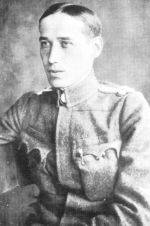
Stefan Stec
Encyclopedia


Poland
Poland , officially the Republic of Poland , is a country in Central Europe bordered by Germany to the west; the Czech Republic and Slovakia to the south; Ukraine, Belarus and Lithuania to the east; and the Baltic Sea and Kaliningrad Oblast, a Russian exclave, to the north...
aviator and military pilot, one of the pioneers of the Polish aviation. He is also credited as the designer of the Polish Air Force's insignia, the checkerboard
Polish Air Force checkerboard
The Air Force checkerboard is a national marking for the aircraft of the Polish Air Force, equivalent to roundels used in other nations' air forces. It consists of four equal squares, of which the upper left and lower right are white, and the other two – red. These are surrounded by a border...
.
Initially a military pilot in Austria-Hungary
Austria-Hungary
Austria-Hungary , more formally known as the Kingdoms and Lands Represented in the Imperial Council and the Lands of the Holy Hungarian Crown of Saint Stephen, was a constitutional monarchic union between the crowns of the Austrian Empire and the Kingdom of Hungary in...
during the Great War
World War I
World War I , which was predominantly called the World War or the Great War from its occurrence until 1939, and the First World War or World War I thereafter, was a major war centred in Europe that began on 28 July 1914 and lasted until 11 November 1918...
. From 1916 he served as an observer in Flik 3 reconnaissance squadron on the eastern front. In February 1918 he himself trained as a pilot and from May he was assigned to Flik 3J fighter squadron, flying on Oeffag D.III on Austro-Italian front. Shortly, between June 17 and July 4 he commanded Flik 9J. He participated in shooting down 3 aircraft (plus 4 probable kills) and ended the war as Oberleutnant.
He was among the first pilots to join the Polish Air Force
Polish Air Force
The Polish Air Force is the military Air Force wing of the Polish Armed Forces. Until July 2004 it was officially known as Wojska Lotnicze i Obrony Powietrznej...
. From November 1918 he took part in the
Polish-Ukrainian War
Polish-Ukrainian War
The Polish–Ukrainian War of 1918 and 1919 was a conflict between the forces of the Second Polish Republic and West Ukrainian People's Republic for the control over Eastern Galicia after the dissolution of Austria-Hungary.-Background:...
, especially Battle of Lwów (1918)
Battle of Lwów (1918)
Battle of Lviv begun on 1 November 1918 and lasted till May 1919 and was a six months long conflict between the forces of the West Ukrainian People's Republic and local Polish civilian population assisted later by regular Polish Army forces for the control...
. He carried out the first bombing sortie on November 7. Lataer he mostly flew on Fokker D.VII
Fokker D.VII
The Fokker D.VII was a German World War I fighter aircraft designed by Reinhold Platz of the Fokker-Flugzeugwerke. Germany produced around 3,300 D.VII aircraft in the summer and autumn of 1918. In service, the D.VII quickly proved itself to be a formidable aircraft...
fighter. In 1919 he shot down a Ukrainian fighter Nieuport 11
Nieuport 11
|-See also:-References:NotesBibliography* Angelucci, Enzio, ed. The Rand McNally Encyclopedia of Military Aircraft. New York: The Military Press, 1983. ISBN 0-517-41021-4....
and a balloon, becoming a fighter ace
Fighter Ace
Fighter Ace was a massively multiplayer online computer game in which one flies World War II fighter and bomber planes in combat against other players and virtual pilots...
. From April to October 1919 he was a commander of the 7th Escadrille
Polish 7th Air Escadrille
Polish 7th Air Escadrille , better known as the Kościuszko Squadron, was one of the units of the Polish Air Force during the Polish-Soviet War of 1919-1921. Formed in late 1918, it was re-formed in late 1919 from US volunteers...
(later to be Kościuszko Squadron). Later he went to France to study in Ecole Superiore d'Aeronautique. After he came back, he was involved in starting the Polish aircraft production. He died in an aircrash in 1921.
His personal emblem from the time of Austrian service, a red and white checkerboard
Polish Air Force checkerboard
The Air Force checkerboard is a national marking for the aircraft of the Polish Air Force, equivalent to roundels used in other nations' air forces. It consists of four equal squares, of which the upper left and lower right are white, and the other two – red. These are surrounded by a border...
, was adopted on December 1, 1918 as the Polish Air Force roundel
Roundel
A roundel in heraldry is a disc; the term is also commonly used to refer to a type of national insignia used on military aircraft, generally circular in shape and usually comprising concentric rings of different colours.-Heraldry:...
.

